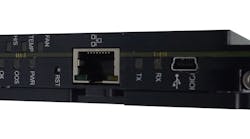By Aaron Frank
ASHBURN, Va. – One technology for building fast, capable systems is to provide high-speed connectivity among system components to transfer and share data quickly for modern signal and data processing.
The need for speed has become critical for modern sensors that rely on increased volumes of efficiently processed data. High speed connectivity between systems also enables more actionable information to be shared quickly, resulting in increased mission effectiveness and more integrated situational awareness.
To deliver the fast processing and information sharing that modern high performance embedded computing (HPEC) defense systems require, system designers must adapt to the latest proven technologies. However, it is not enough simply to provide high-speed connectivity between system components yet fail to support the ability to process all that data within the systems themselves.
100-Gigabit Ethernet products, such as the latest systems designed to align with the Sensor Open Systems Architecture (SOSA) technical standard, must be able to deliver full 100-gigabit performance throughout the entire processing chain or they will fail to achieve the true potential of this exciting new technology.
Related: Data and networking push advances in embedded computing
Leading COTS suppliers have focused on increasing connectivity speeds within and between systems for decades. Following the introduction of the VPX standard in 2006, and the subsequent emergence of the OpenVPX architecture for designing systems with VPX boards and backplanes, system throughput has steadily advanced from 1- to 40-gigabit ecosystems, and processing architectures have been able to keep pace with the increased data rates and processing complexities.
Systems based on these architectures currently serve worldwide as the trusted processing and networking foundation of many of today’s defense programs. As silicon technologies with support for 100 gigabit and faster connectivity have become available and affordable in the commercial world, aerospace and defense COTS suppliers have begun to engineer and prove the technologies necessary to create system building blocks based on high-speed signaling techniques that support the 25-gigabaud data rates needed for 100-Gigabit Ethernet connectivity, and the 16-gigabaud data rates needed for PCI Express Gen4 connectivity.
High-fidelity sensors require massive data superhighways to deliver real-time data to sensor processors. To take full advantage of 100-gigabit connectivity in an embedded computing system the processing elements must be able to supply and consume the data at high speed without the impediment of other architectural bottlenecks.
Processing systems require new and innovative hardware and software architectures to eliminate any data processing bottlenecks or the fidelity benefits of the sensors never maybe realized. Finally, networks used to share information between systems must also leverage bottleneck-free technologies to enable more actionable information to be efficiently shared for increased mission success.
Related: Sensor and signal processing embedded computing at the speed of battle
One of the main challenges in using new technology to build robust systems is integrating disparate components from different vendors and managing technology integration risks by ensuring that the components and all parts of the system work together.
Designing leading-edge 100-gigabit technology today requires more design rigor than ever before. At the module and at the system level, designs must be meticulously modeled and tested with considerations for the operating environment and optimized across the entire processing chain to truly take advantage of the increased volume of data. Now, more than ever before, interoperability is increasingly critical to ensure that actionable information can be extracted and shared for optimal mission success.
Curtiss Wright Defense Solutions in Ashburn, Va., has announced the first products in a portfolio of 100-gigabit Ethernet and PCI Express Gen 4 based modules, called the Fabric100 product family. These products enable system integrators to take advantage of fast connectivity with module and system architectures capable of processing the great amounts of data while reducing integration risks across the entire processing chain.
These 100-gigabit products are a pair of 6U OpenVPX high-performance processing modules for sensor ingest and advanced processing for next-generation Radar and SIGINT systems. This new product family is aligned with MOSA open standards, such as SOSA, to deliver a foundation for new system designs, both today and in the future, enabling new system designs that deliver the critical information our armed forces need, and delivering it at the speed of relevance.
Aaron Frank is senior product manager at Curtiss-Wright Defense Solutions in Ashburn, Va.



